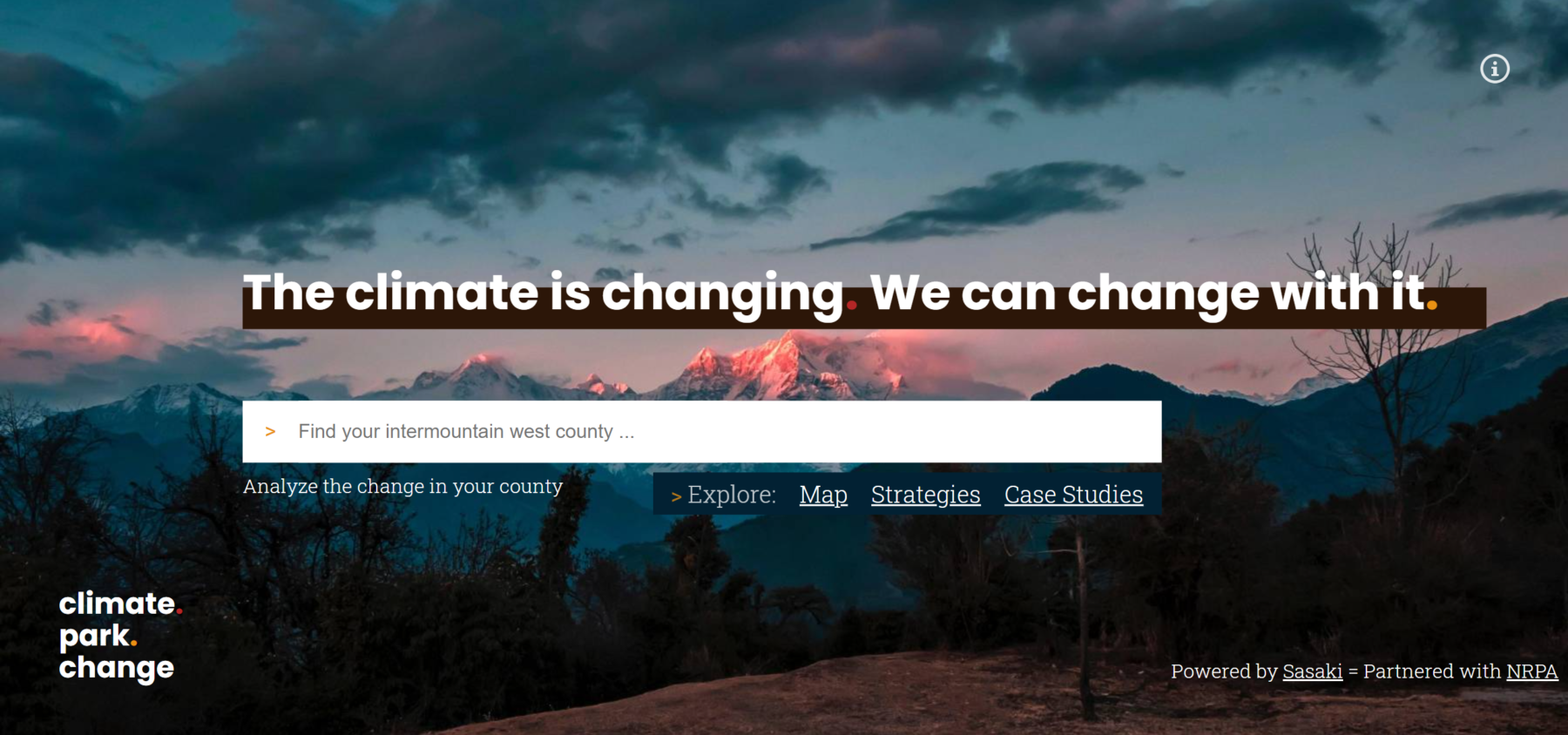2020 Research Grant Winners Announced
Research at Sasaki evolves with three new sponsored projects announced for the new year
 Sasaki
Sasaki

2020 was the hottest year on record, highlighting that we are experiencing the impacts of climate change now. Park and recreation professionals, who serve nearly every community in the U.S., are poised to advance climate mitigation and adaptation strategies to build environmental and community resiliency through the power of local parks and recreation.
However, understanding the specific climate change challenges facing each community and developing associated strategies park and recreation professionals can utilize is difficult and at best, as few aggregated resources on the subject exist. As part of Sasaki’s 2020 research grant program, Sasaki, in partnership with the National Recreation and Park Association (NRPA) created a toolkit for resilient parks: Climate.Park.Change.
Climate.Park.Change., a web-based platform, compiles data on how climate change affects park and recreation spaces and suggests physical design solutions that address climate impacts as well as other community challenges. This toolkit initially focuses on the Intermountain West region, an area identified where research is lacking compared to most coastal cities and towns. The ultimate goal of this toolkit is to give park and recreation professionals the tools needed to create climate-ready parks and build community and environmental resilience.
The toolkit will allow professionals to explore regional impacts arising from climate change and associated climate adaptation design strategies. These strategies will be tailored for the park and recreation profession to adapt their infrastructure to combat the climate-related environmental, health, social, and economic impacts facing their communities. The tool will prioritize strategies that are replicable across varying park and recreation systems, achieve maximum community improvement, and promote equitable investment.
Sasaki and NRPA started the process in early 2020 by understanding and identifying the climate change issues, actual and perceived, that are impacting the Intermountain West area of the United States. To better understand the perceived issues, the team interviewed park and recreation professionals from 13 municipal agencies across the mid-US to hear about their current challenges and understand future needs. The team asked questions about expenditure, community perception of climate change, current response to mitigate the changing environmental threats, and ways they needed support. Parallel to this process, the team researched existing data and white papers to better understand trends and impacts directly associated with climate change.
After five months of interviews, gathering information, and processing data, the team created a list of major climate change issues specifically impacting the Intermountain West, including wildfires, landslide and avalanches, extended drought, inland flooding, extreme wind events, heatwave, reduced annual precipitation, extreme precipitation events, poor air quality, diminishing snowpack, erosion, water quality issues, invasive species, and pest and pathogen outbreaks. The team then studied each of these issues and created a series of “Threat Cards” that define the issue, how it is related to climate change, maps of where it is impacting the region, resources on that particular issue, and other issues that threat was linked to. For each issue, the team also looked at how it was impacting parks and recreation operation and maintenance, ecosystem functionality, and access.
After identifying key issues, the team began developing a collection of strategies, tailored to the Intermountain West, that park and recreation professionals can deploy to address challenges posed by climate change. These strategies were informed by research, interviews with park and recreation professionals, and workshops
The 200+ strategies are organized into three categories: (1) Ecosystem Functionality, (2) Parks, Operations, & Maintenance, and (3) Users & Access. These categories are designed to help users of the Climate.Park.Change. Website find strategies that are specific to their challenges and needs.
The team also developed a suitability system to categorize the strategies through tags such as equity, size of the park, the slope of the landscape, surrounding context, and geographic region applicability. Finally, the strategies are meant to be a free, open-sourced library that can continuously grow as park and recreation professionals, designers, and users actively add new strategies through a survey on the webstie.
To conceptually test the strategies, the team collaborated through a series of workshops with three park and recreation agencies in the region – Evanston, WY, Salt Lake City, UT, and Denver, CO. Study sites were chosen for their representation of a variety of issues; the three sites —The Bear Meadow (WY), Glendale Water Park (UT), and West-bar-Val-wood Park (CO) — varied in terms of size, use, and landscape features. Sasaki, NRPA, and each park and recreation agency engaged in a two-hour interactive virtual workshop, which brought together the perspectives of park managers, park advocates, and park designers. This two-month process included an initial site analysis, issue identification, strategy brainstorming, and documentation. The information developed from these workshops helped refine the proposed strategies and served as a pilot for how the interactive toolkit can be applied to equip park and recreation professionals with the tools to implement climate mitigation and adaptation approaches.
The web-based interactive toolkit is meant to first help users understand the issues associated with climate change and how the issues influence parks and recreation. Secondly, it provides useful strategies that are tailored for specific geographies. Finally, it showcases how this toolkit can be used to identify strategies based on specific challenges through the three case studies. This website offers a look into the footprint of each identified climate change issue through an interactive map as users can switch between layers of data that paints the impacts at the county level. As the site grows, strategic contributions from users will be encouraged through a crowd-sourcing interface, adding further strategies that can be applied.